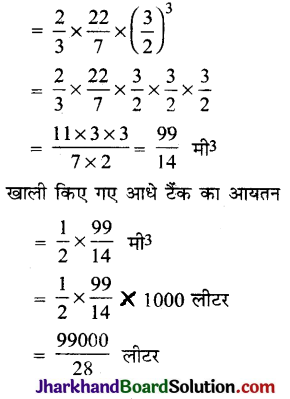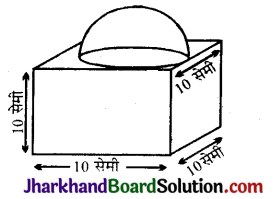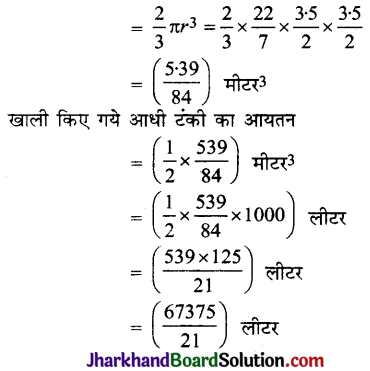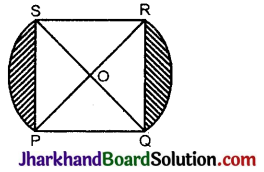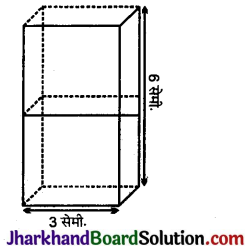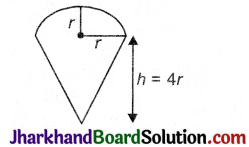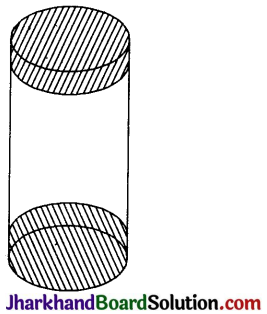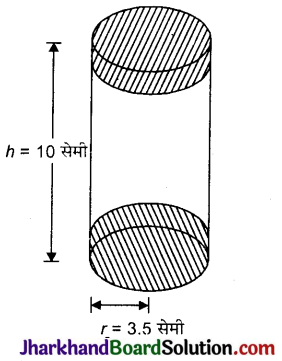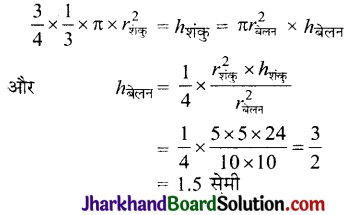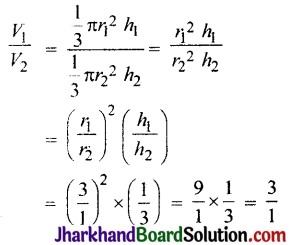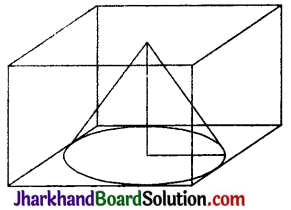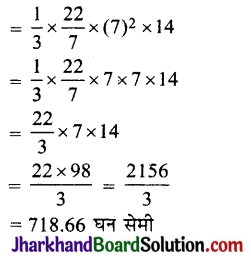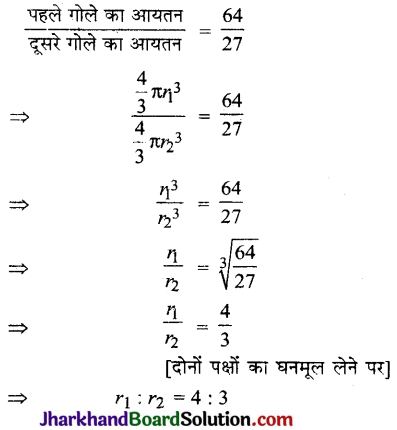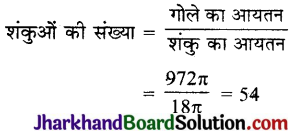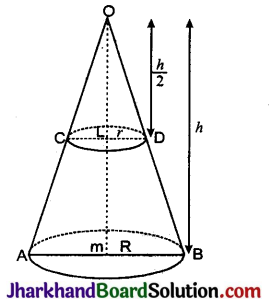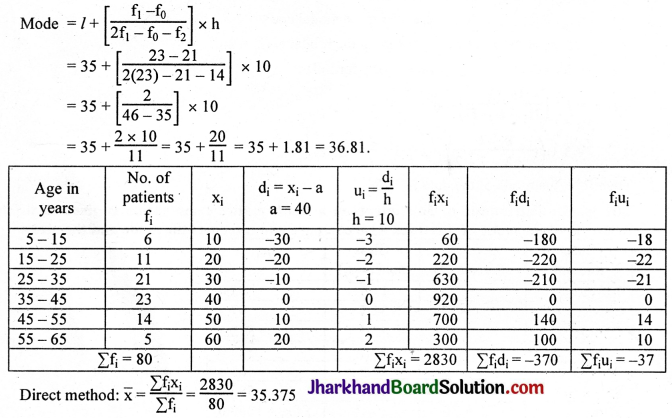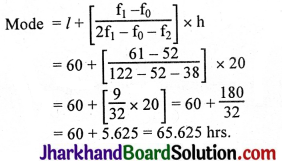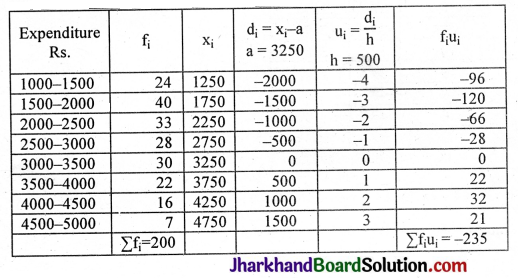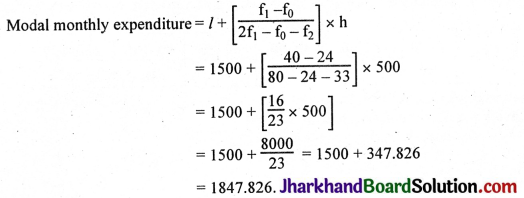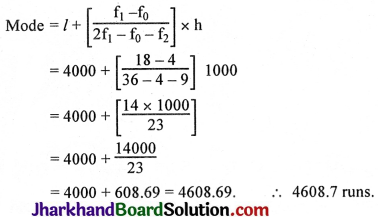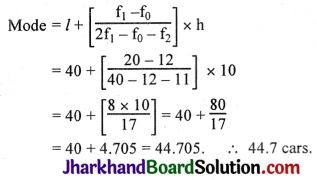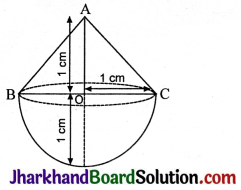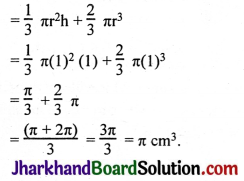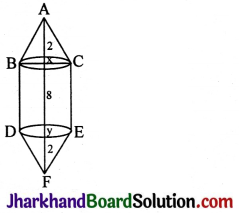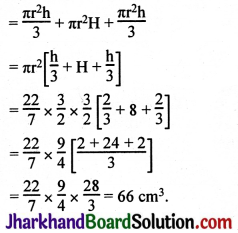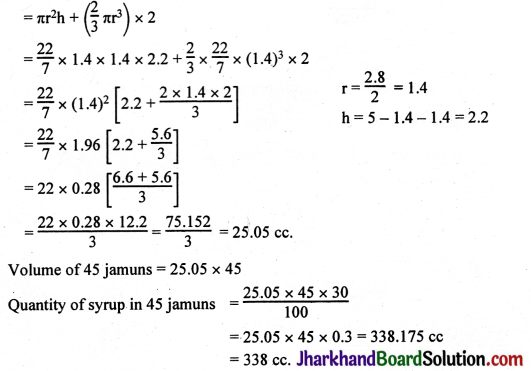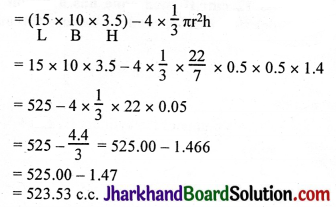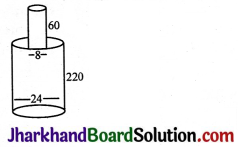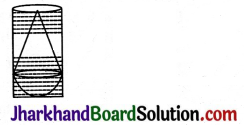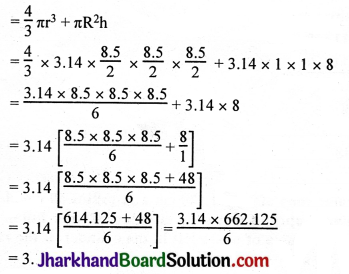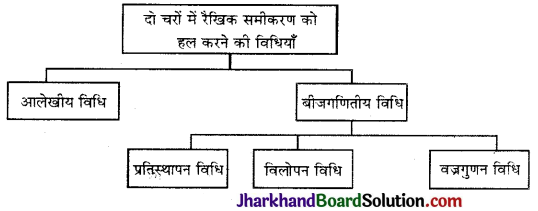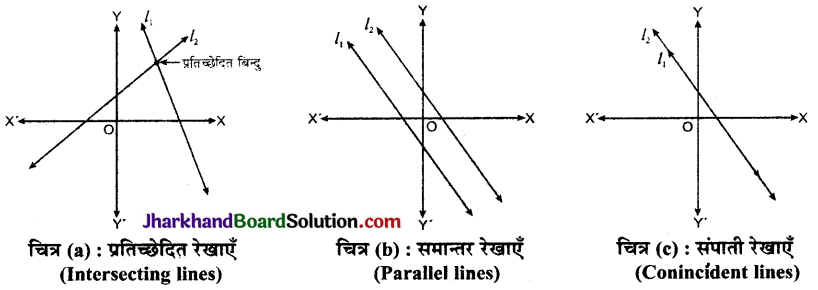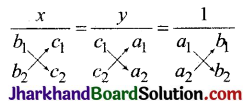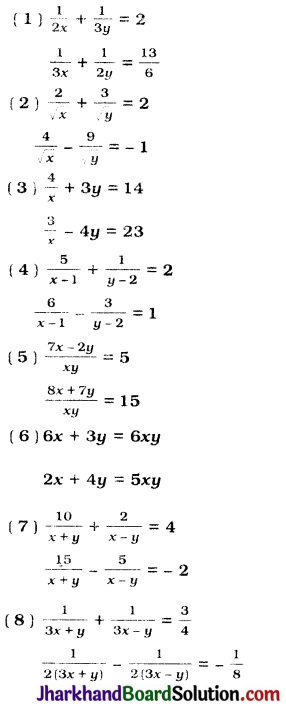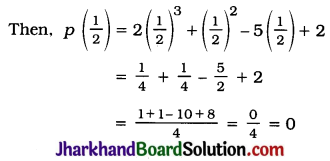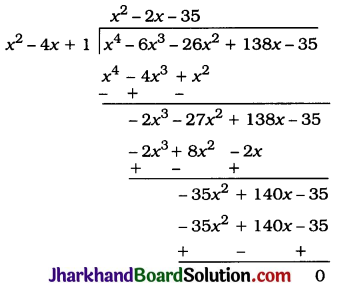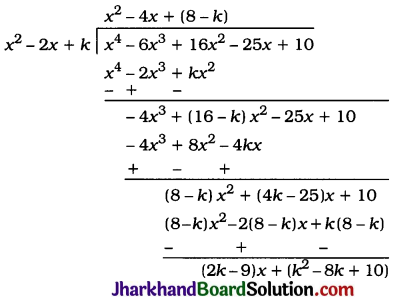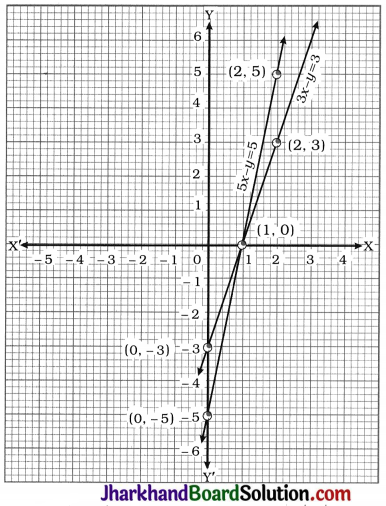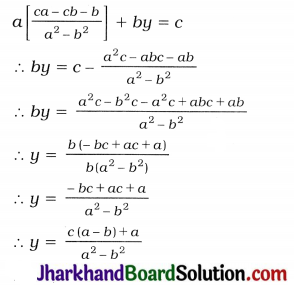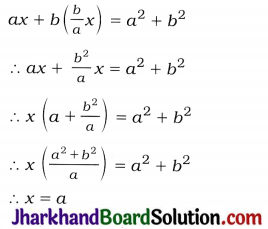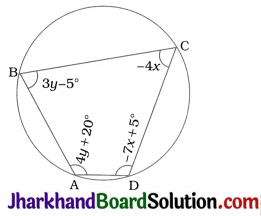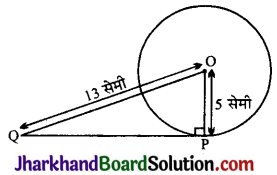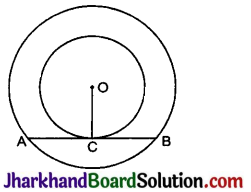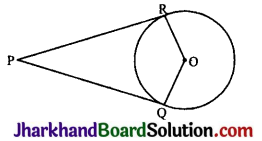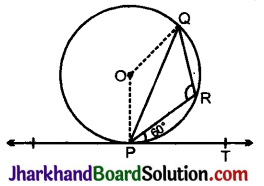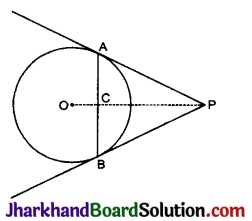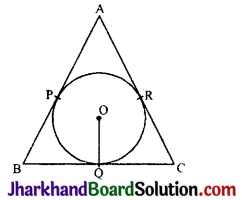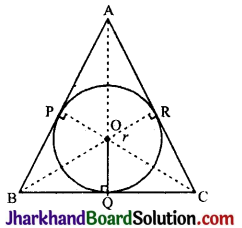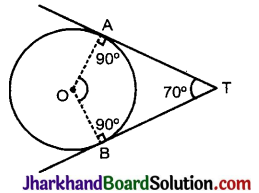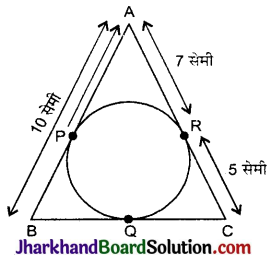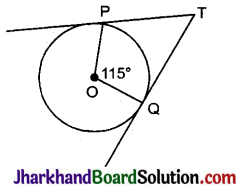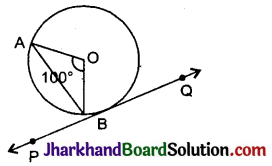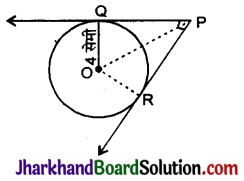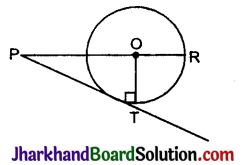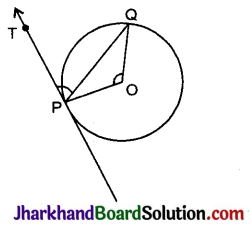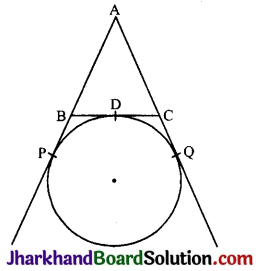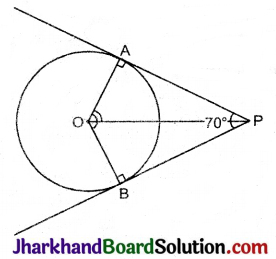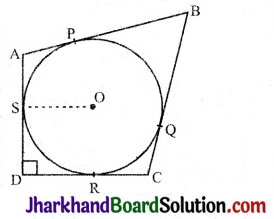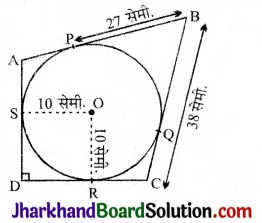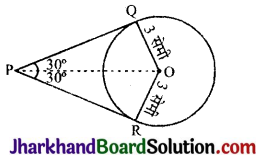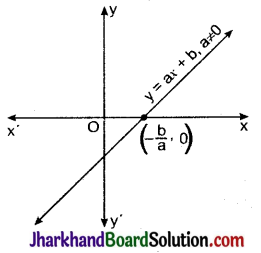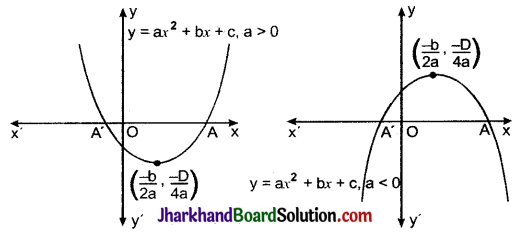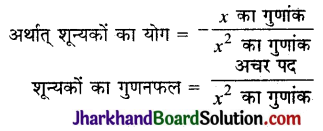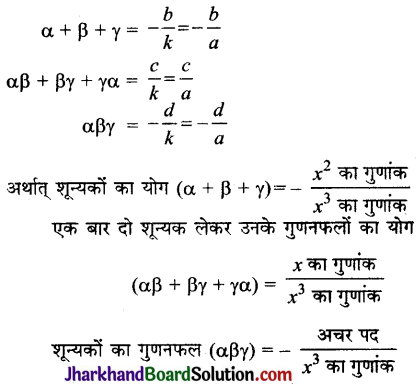Jharkhand Board JAC Class 10 Maths Solutions Chapter 5 Arithmetic Progressions Ex 5.3 Textbook Exercise Questions and Answers.
JAC Board Class 10 Maths Solutions Chapter 5 Arithmetic Progressions Exercise 5.3
Question 1.
Find the sum of following APs:
1. 2, 7, 12, ……, to 10 terms.
2. -37, -33, -29, ……, to 12 terms.
3. 0.6, 1.7, 2.8, ……, to 100 terms.
4. \(\frac{1}{15}, \frac{1}{12}, \frac{1}{10}, \ldots\) to 11 terms.
Solution:
1. For the given AP 2, 7, 12, ……., a = 2.
d = 7 – 2 = 5, n = 10 and Sn is to be found.
Sn = \(\frac{n}{2}\)[2a + (n – 1)d]
S10 = \(\frac{10}{2}\)[4 + (10 – 1) 5]
= 5(49) = 245
Thus, the sum of first 10 terms of the given AP is 245.
2. For the given AP -37, -33, -29, a = -37, d = (-33) – (-37) = 4, n = 12 and Sn is to be found.
Sn = \(\frac{n}{2}\)[2a + (n – 1)d]
S12 = \(\frac{12}{2}\)[-74 + (12 – 1)4]
= 6(-30) = – 180
Thus, the sum of first 12 terms of the given AP is -180.
3. For the given AP 0.6, 1.7, 2.8,…… a = 0.6, d = 1.7 – 0.6 = 1.1, n = 100 and Sn is to be found.
Sn = \(\frac{n}{2}\)[2a + (n – 1) d]
∴ S100 = \(\frac{100}{2}\)[1.2 + (100 – 1) (1.1)]
= 50[1.2 + 108.9]
= 50 × 110.1 = 5505
Thus, the sum of first 100 terms of the given AP is 5505.
4.
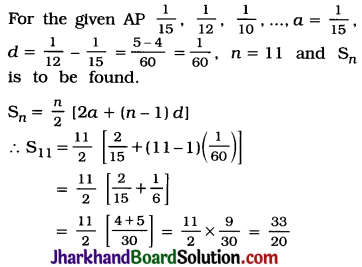
Thus, the sum of first 11 terms of the given AP is \(\frac{33}{20}\).

Question 2.
Find the sums given below:
1. 7 + 10\(\frac{1}{2}\) + 14 + … + 84
2. 34 + 32 + 30 + … + 10
3. (-5) + (-8) + (-11) + … + (-230)
Solution:
1. 7 + 10\(\frac{1}{2}\) + 14 + …… + 84
Here, a = 7; d = 10\(\frac{1}{2}\) – 7 = 3\(\frac{1}{2}\); last term l = 84.
Let the last term be nth term.
an = a + (n – 1)d
∴ 84 = 7 + (n – 1) (3\(\frac{1}{2}\))
∴ 77 = \(\frac{7}{2}\)(n – 1)
∴ (n – 1) = 22
∴ n = 23
Now,
Sn = \(\frac{n}{2}\)(a + l), where l is the last term.
= \(\frac{23}{2}\)(7 + 84)
= \(\frac{23}{2}\) × 91 = 1046\(\frac{1}{2}\)
Thus, the required sum is 1046\(\frac{1}{2}\).
2. 34 + 32 + 30 + … + 10
Here, a = 34; d = 32 – 34 = (-2); last term l = 10.
Let the last term be nth term.
an = a + (n – 1)d
∴ 10 = 34 + (n – 1)(-2)
∴ -24 = -2(n – 1)
∴ (n – 1) = 12
∴ n = 13
Now,
Sn = \(\frac{n}{2}\)(a + l), where l is the last term.
= \(\frac{13}{2}\)(34 + 10)
= 13 × 22 = 286
Thus, the required sum is 286.
3. (-5) + (-8) + (-11) + … + (-230)
Here, a = (-5); d = (-8) – (-5) = (-3):
last term l = (-230).
Let the last term be nth term.
an = a + (n – 1)d
∴ -230 = -5 + (n – 1)(-3)
∴ -225 = -3 (n – 1)
∴ n – 1 = 75
∴ n = 76
Now,
Sn = \(\frac{n}{2}\)(a + l), where l is the last term.
= \(\frac{76}{2}\)[(-5) + (-230)]
= 38(-235) = -8930
Thus, the required sum is -8930.

Question 3.
In an AP:
1. Given a = 5, d = 3, an = 50, find n and Sn.
2. Given a = 7, a13 = 35, find d and S13.
3. Given a12 = 37, d = 3, find a and S12.
4. Given a3 = 15, S10 = 125, find d and a10.
5. Given d = 5, S9 = 75, find a and a9.
6. Given a = 2, d = 8, Sn = 90, find n and an.
7. Given a = 8, an = 62, Sn = 210, find n and d.
8. Given an = 4, d = 2, Sn = -14, find n and a.
9. Given a = 3, n = 8, Sn = 192, find d.
10. Given l = 28, Sn = 144, and there are total 9 terms. Find a.
Solution:
1. a = 5, d = 3, an = 50, n = ? Sn = ?
an = a + (n – 1)d
∴ 50 = 5 + (n – 1)3
∴ 45 = 3(n – 1)
∴ 15 = n – 1
∴ n = 16
Sn = \(\frac{n}{2}\)(a + l)
∴ S16 = \(\frac{16}{2}\)(5 + 50)
∴ S16 = 8 × 55
∴ S16 = 440
2. a = 7, a13 = 35, d = ?, S13 = ?
an = a + (n – 1)d
a13 = a + (13 – 1) d
∴ 35 = 7 + 12d
∴ 28 = 12d
∴ d = \(\frac{28}{12}\)
∴ d = \(\frac{7}{3}\)
Sn = \(\frac{n}{2}\)(a + l)
∴ S13 = \(\frac{13}{2}\)(17 + 35)
∴ S13 = 13 × 21
∴ S13 = 273
3. a12 = 37, d = 3, a = ?, S12 = ?
an = a + (n – 1)d
∴ a12 = a + 11d
∴ 37 = a + 11 (3)
∴ a = 4
Sn = \(\frac{n}{2}\)(a + l)
∴ S12 = \(\frac{12}{2}\)(4 + 37)
∴ S12 = 246
4. a3 = 15, S10 = 125, d = ?, a10 = ?
an = a + (n – 1)d
∴ a3 = a + 2d
∴ a + 2d = 15 …….(1)
Sn = \(\frac{n}{2}\)[2a + (n – 1) d]
∴ S10 = \(\frac{10}{2}\)[2a + 9d]
∴ S125 = 5(2a + 9d)
∴ 2a + 9d = 25 …….(2)
Solving equations (1) and (2), we get
d = -1 and a = 17.
an = a + (n – 1)d
∴ a10 = a + 9d
∴ a10 = 17 + 9(-1)
∴ a10 = 8
5. d = 5, S9 = 75, a = ?, a9 = ?
Sn = \(\frac{n}{2}\)[2a + (n – 1) d]
∴ S9 = \(\frac{9}{2}\)[2a + (9 – 1) d]
∴ 75 = \(\frac{9}{2}\)[2a + 8(5)]
∴ 75 = 9(a + 20)
∴ \(\frac{25}{3}\) = a + 20
∴ a = \(\frac{25}{3}\) – 20
∴ a = –\(\frac{35}{3}\)
an = a + (n – 1) d
∴ a9 = a + 8d
∴ a9 = (-\(\frac{35}{3}\)) + 8(5)
∴ a9 = –\(\frac{35}{3}\) + 40
∴ a9 = \(\frac{85}{3}\)
6. a = 2, d = 8, Sn = 90, n = ?, an = ?
Sn = \(\frac{n}{2}\)[2a + (n – 1) d]
∴ 90 = \(\frac{n}{2}\)[4 + (n – 1)8]
∴ 90 = \(\frac{n}{2}\)[8n – 4]
∴ 90 = n (4n – 2)
∴ 4n2 – 2n – 90 = 0
∴ 2n2 – n – 45 = 0
∴ 2n2 – 10n + 9n – 45 = 0
∴ 2n (n – 5) + 9 (n – 5) = 0
∴ (n – 5) (2n + 9) = 0
∴ n – 5 = 0 or 2n + 9 = 0
∴ n = 5 or n = –\(\frac{9}{2}\)
Since n is a positive integer, n ≠ –\(\frac{9}{2}\)
∴ n = 5
an = a + (n – 1)d
∴ a5 = a + 4d
∴ a5 = 2 + 4(8)
∴ a5 = 34
7. a = 8, an = 62, Sn = 210, n = ? d = ?
Sn = \(\frac{n}{2}\)(a + l)
∴ Sn = \(\frac{n}{2}\)(a + an)
∴ 210 = \(\frac{n}{2}\)(8 + 62)
∴ 420 = n (70)
∴ n = 6
an = a + (n – 1)d
∴ a6 = a + 5d
∴ 62 = 8 + 5d
∴ 54 = 5d
∴ d = \(\frac{54}{5}\)
8. an = 4, d = 2, Sn = -14, n = ?, a = ?
an = a + (n – 1)d
∴ 4 = a + (n – 1) (2)
∴ 4 = a + 2n – 2
∴ a = 6 – 2n
Sn = \(\frac{n}{2}\)[2a + (n – 1) d]
∴ -14 = \(\frac{n}{2}\)[2 (6 – 2n) + (n – 1) (2)] (by (1))
∴ -14 = \(\frac{n}{2}\)[12 – 4n + 2n – 2]
∴ -14 = \(\frac{n}{2}\)[-2n + 10]
∴ -14 = n(-n + 5)
∴ -14 = -n2 + 5n
∴ n2 – 5n – 14 = 0
∴ (n – 7)(n + 2) = 0
∴ n – 7 = 0 or n + 2 = 0
∴ n = 7 or n = -2
Since n is a positive integer, n ≠ -2.
∴ n = 7
By (1), a = 6 – 2n
∴ a = 6 – 2(7)
∴ a = -8
9. a = 3, n = 8, Sn = 192, d = ?
Sn = \(\frac{n}{2}\)[2a + (n – 1) d]
∴ 192 = \(\frac{8}{2}\)[6 + (8 – 1) d]
∴ 192 = 4[6 + 7d]
∴ 48 = 6 + 7d
∴ 42 = 7d
∴ d = 6
10. l = 28, Sn = 144, n = 9, a = ?
Sn = \(\frac{n}{2}\)(a + l)
∴ 144 = \(\frac{9}{2}\)(a + 28)
∴ 32 = (a + 28)
∴ a = 4

Question 4.
How many terms of the AP 9, 17, 25, … must be taken to give a sum of 636?
Solution:
Here, a = 9; d = 17 – 9 = 8; Sn = 636, n = ?
Sn = \(\frac{n}{2}\)[2a + (n – 1) d]
∴ 636 = \(\frac{n}{2}\)[18 + (n – 1)8]
∴ 636 = \(\frac{n}{2}\)[10 + 8n]
∴ 636 = n[4n + 5]
∴ 4n2 + 5n – 636 = 0
Here, a = 4; b = 5; c = -636
b2 – 4ac = (5)2 – 4(4)(-636)
= 25 + 10176
= 10201
∴ \(\sqrt{b^2-4 a c}=\sqrt{10201}=101\)
Then, n = \(\frac{-b \pm \sqrt{b^2-4 a c}}{2 a}\)
∴ n = \(\frac{-5 \pm 101}{8}\)
∴ n = \(\frac{96}{2}\) or n = \(\frac{-106}{8}\)
∴ n = 12 or n = \(-\frac{53}{4}\)
As n denotes the numbers of terms, it is a positive integer.
∴ n = \(-\frac{53}{4}\) is not possible.
∴ n = 12
Thus, 12 terms of the AP 9, 17, 25,… must be taken to give a sum of 636.
Question 5.
The first term of an AP is 5, the last term is 45 and the sum is 400. Find the number of terms and the common difference.
Solution:
Here, a = 5; l = 45; Sn = 400; n = ?; d = ?
Sn = \(\frac{n}{2}\)(a + l)
∴ 400 = \(\frac{n}{2}\)(5 + 45)
∴ 800 = n (50)
∴ n = 16
l = an = a + (n – 1)d
∴ a16 = a + 15d
∴ 45 = 5 + 15d
∴ 40 = 15d
∴ d = \(\frac{40}{15}\)
∴ d = \(\frac{8}{3}\)
Thus, the number of terms is 16 and the common difference is \(\frac{8}{3}\).
Question 6.
The first and the last terms of an AP are 17 and 350 respectively. If the common difference is 9, how many terms are there and what is their sum?
Solution:
Here, a = 17; l = an = 350; d = 9; n = ?; Sn = ?
an = a + (n – 1)d
∴ 350 = 17 + (n – 1)9
∴ 333 = 9 (n – 1)
∴ n – 1 = 37 ∴ n = 38
Again, Sn = \(\frac{n}{2}\)(a + l)
∴ S38 = \(\frac{38}{2}\)(17 + 350)
∴ S38 = 19 × 367
∴ S38 = 6973
Thus, there are 38 terms and their sum is 6973.

Question 7.
Find the sum of first 22 terms of an AP in which d = 7 and 22nd term is 149.
Solution:
Here, a22 = 149; d = 7; S22 = ?
an = a + (n – 1) d
∴ a22 = a + 21d
∴ 149 = a + 21 × 7
∴ a = 149 – 147
∴ a = 2
Now, Sn = \(\frac{n}{2}\)(a + l)
∴ S22 = \(\frac{22}{2}\)(2 + 149)
∴ S22 = 11 × 151
∴ S22 = 1661
Thus, the sum of first 22 terms of the given AP is 1661.
Question 8.
Find the sum of first 51 terms of an AP whose second and third terms are 14 and 18 respectively.
Solution:
Here, a2 = 14; a3 = 18; S51 = ?
an = a + (n – 1)d
∴ a2 = a + d = 14 ……..(1)
∴ a3 = a + 2d = 18 ……..(2)
Solving equations (1) and (2), we get
d = 4 and a = 10.
Sn = \(\frac{n}{2}\)[2a + (n – 1)d]
∴ S51 = \(\frac{51}{2}\)[20 + 50 × 4]
∴ S51 = 51 × 110
∴ S51 = 5610
Thus, the sum of first 51 terms of the given AP is 5610.
Question 9.
If the sum of first 7 terms of an AP is 49 and that of 17 terms is 289, find the sum of first n terms.
Solution:
Here, S7 = 49; S17 = 289: Sn = ?
Sn = \(\frac{n}{2}\)[2a + (n – 1)d]
∴ S7 = \(\frac{7}{2}\)[2a + 6d]
∴ 49 = 7(a + 3d)
∴ a + 3d = 7 ……..(1)
Again S17 = \(\frac{17}{2}\)[2a + 16d]
∴ 289 = 17(a + 8d)
∴ a + 8d = 17 ……..(2)
Solving equations (1) and (2), we get d = 2 and a = 1.
∴ Sn = \(\frac{n}{2}\)[2a + (n – 1) d]
∴ Sn = \(\frac{n}{2}\)[2 + (n – 1)2]
∴ Sn = \(\frac{n}{2}\)[2 + 2n – 2]
∴ Sn = \(\frac{n}{2}\)(2n)
∴ Sn = n2
Thus, the sum of first n terms of the given AP is n2.

Question 10.
Show that a1, a2, ……., an, ……. form an AP where a is defined as below:
1. an = 3 + 4n
2. an = 9 – 5n
Also find the sum of the first 15 terms in each case.
Solution:
1. an = 3 + 4n
a1 = 3 + 4(1) = 7,
a2 = 3 + 4(2) = 11,
a3 = 3 + 4(3) = 15,
a4 = 3 + 4(4) = 19 and so on.
Here, a4 – a3 = a3 – a2 = a2 – a1 = 4.
Hence, ak+1 – ak remains the everywhere.
Hence, a1, a2, a3, ….. defined as an = 3 + 4n form an AP in which a = 7 and d = 4.
Sn = \(\frac{n}{2}\)[2a + (n – 1)d]
∴ S15 = \(\frac{15}{2}\)[14 + 14 × 4]
∴ S15 = 15 × 35
∴ S15 = 525
The sum of first 15 terms of the given AP is 525.
2. an = 9 – 5n
a1 = 9 – 5(1) = 4,
a2 = 9 – 5(2) = -1,
a3 = 9 – 5(3) = -6,
a4 = 9 – 5(4) = -11 and so on.
Here, a4 – a3 = a3 – a2 = a2 – a1 = -5.
Hence, ak+1 – ak remains the same everywhere.
Hence, a1, a2, a3, ….. defined as an = 9 – 5n form an AP in which a = 4 and d = -5.
Sn = \(\frac{n}{2}\)[2a + (n – 1) d]
∴ S15 = \(\frac{15}{2}\)[8 + 14 (-5)]
∴ S15 = \(\frac{15}{2}\)(-62)
∴ S15 = 15 × (-31)
∴ S15 = -465
The sum of first 15 terms of the given AP is -465.
Question 11.
If the sum of the first n terms of an AP is 4n – n2, what is the first term (that is S1)? What is the sum of first two terms? What is the second term? Similarly, find the 3rd, the 10th and the nth terms.
Solution:
For the given AP
Sn = 4n – n2
∴ S1 = 4(1) – (1)2 = 4 – 1 = 3,
S2 = 4 (2) – (2)2 = 8 – 4 = 4,
S3 = 4(3) – (3)2 = 12 – 9 = 3,
S9 = 4 (9) – (9)2 = 36 – 81 = -45,
S10 = 4 (10) – (10)2 = 40 – 100 = -60
Now, the first term = a – a1 = S1 = 3
The sum of first two terms S2 = 4
The second term a2 = S2 – S1 = 4 – 3 = 1
The third term a3 = S3 – S2 = 3 – 4 = -1
The tenth term a10 = S10 – S9
= -60 – (-45) = -15
Now, Sn = 4n – n2
∴ Sn-1 = 4(n – 1) – (n – 1)2
= 4n – 4 – n2 + 2n – 1
= -n2 + 6n – 5
Now nth term an = Sn – Sn-1
∴ an = (4n – n2) – (-n2 + 6n – 5)
∴ an = 4n – n2 + n2 – 6n + 5
∴ an = -2n + 5
Question 12.
Find the sum of the first 40 positive integers divisible by 6.
Solution:
The first 40 positive integers divisible by 6 form the AP 6, 12, 18, ……, 240.
Here, a = 6; d = 12 – 6 = 6; n = 40 and l = 240.
Sn = \(\frac{n}{2}\)(a + l)
∴ S40 = \(\frac{40}{2}\)(6 + 240)
∴ S40 = 20 × 246
∴ S40 = 4920
Thus, the required sum is 4920.
Alternate method:
Required sum
= 6 + 12 + 18 + … + 240
= 6(1 + 2 + 3 + … + 40)
= 6 × \(\frac{40 \times 41}{2}\) (1 + 2 + 3 + …. + n = \(\frac{n(n+1)}{2}\))
= 4920
Question 13.
Find the sum of the first 15 multiples of 8.
Solution:
The first 15 multiples of 8 form the AP 8, 16, 24, ….., 120.
Here, a = 8, d = 16 – 8 = 8, n = 15 and l = 120.
Sn = \(\frac{n}{2}\)(a + l)
∴ S15 = \(\frac{15}{2}\)(8 + 120)
∴ S15 = 15 × 64
∴ S15 = 960
Thus, the required sum is 960.
Alternate method:
Required sum
= 8 + 16 + 24 + … + 120
= 8(1 + 2 + 3 + … + 15)
= 8 × \(\frac{15 \times 16}{2}\) (1 + 2 + 3 + … + n = \(\frac{n(n+1)}{2}\))
= 960.

Question 14.
Find the sum of the odd numbers between 0 and 50.
Solution:
The odd numbers between 0 and 50 form the AP 1, 3, 5, ….., 49.
Here, a = 1, d = 3 – 1 = -2, l = 49.
Let the last term be the nth term.
an = a + (n – 1) d
49 = 1 + (n – 1)2
2(n – 1) = 48
n – 1 = 24
n = 25
Now, Sn = \(\frac{n}{2}\)(a + l)
∴ S25 = \(\frac{25}{2}\)(1 + 49)
∴ S25 = 25 × 25
∴ S25 = 625
Thus, the required sum is 625.
Question 15.
A contract on construction job specifies a penalty for delay of completion beyond a certain date as follows: ₹ 200 for the first day, ₹ 250 for the second day, ₹ 300 for the third day, etc.. the penalty for each succeeding day being ₹ 50 more than for the preceding day. How much money the contractor has to pay as penalty, if he has delayed the work by 30 days?
Solution:
The sums (in rupees) of penalty for delay of completion form the AP 200, 250, 300, …..
Here, a = 200; d = 250 – 200 = 50; n = 30 as the contractor has delayed the work by 30 days. The total penalty amount (in rupees) to be paid by the contractor will be given by S30.
Sn = \(\frac{n}{2}\)[2a + (n – 1)d]
∴ S30 = \(\frac{30}{2}\)[400 + (30 – 1)50]
∴ S30 = 15 × 1850
∴ S30 = 27750
Thus, the contractor has to pay a penalty of ₹ 27,750.
Question 16.
A sum of ₹ 700 is to be used to give seven cash prizes to students of a school for their overall academic performance. If cach prize is 20 less than its preceding prize, find the value of each of the prizes.
Solution:
₹ 700 is to be distributed as seven prizes such that each prize is ₹ 20 less than its preceding prize. Let the highest prize, i.e., the first prize be ₹ a. Then, the second prize will be of ₹ a – 20, the third prize will be of ₹ a – 40 and so on up to seven prizes. Hence, the amount (in rupees) of these prizes form a finite AP with seven terms as a, a – 20, a – 40, a – 60, a – 80, a – 100 and a – 120.
Here, the first term = a; d = (a – 20) – a = -20;
n = 7 and the sum of all the terms = S7 = 700.
Sn = \(\frac{n}{2}\)[2a + (n – 1) d]
∴ 700 = \(\frac{7}{2}\)[2a + (7 – 1) (-20)]
∴ 200 = 2a + 6(-20)
∴ 200 = 2a – 120
∴ 2a = 320
∴ a = 160
Then, a – 20 = 140; a – 40 = 120; a – 60 = 100; a – 80 = 80; a – 100 = 60 and a – 120 = 40.
Thus, the values (in rupees) of those seven prizes are 160, 140, 120, 100, 80, 60 and 40.

Question 17.
In a school, students thought of planting trees in and around the school to reduce air pollution. It was decided that the number of trees, that each section of each class. will plant, will be the same as the class, in which they are studying, e.g.. a section of Class I will plant 1 tree, a section of Class II will plant 2 trees and so on till Class XII. There are three sections of each class. How many trees will be planted by the students?
Solution:
The number of trees that the three sections of Class I will plant = 1 + 1 + 1 = 3.
The number of trees that the three sections of Class II will plant = 2 + 2 + 2 = 6.
This system will continue till Class XII.
The number of trees that the three sections of Class XII will plant = 12 + 12 + 12 = 36.
Thus, the number of trees that will be planted will form a finite AP with 12 terms as 3, 6, 9, ….., 36.
Here, a = 3, d = 6 – 3 = 3, n = 12 and S12 will give the total number of trees that will be planted.
Sn = \(\frac{n}{2}\)[2a + (n – 1) d]
∴ S12 = \(\frac{12}{2}\)[6 + (12 – 1)3]
∴ S12 = 6 × 39
∴ S12 = 234
Thus, 234 trees will be planted by the students.
Question 18.
A spiral is made up of successive semicircles, with centres alternately at A and B, starting with centre at A, of radii 0.5 cm, 1.0 cm, 1.5 cm, 2.0 cm, as shown in the given figure. What is the total length of such a spiral made up of thirteen consecutive semicircles? (Take π = \(\frac{22}{7}\))
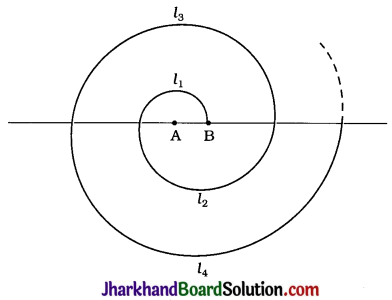
Hint: Length of successive semicircles is l1, l2, l3, l4, …with centres at A, B, A, B, ….., respectively.]
Solution:
We know that the length of a semicircle = πr, where r is the radius.
Length of 1st semicircle with centre A and radius 0.5 cm = l1 = π × 0.5 cm.
Length of 2nd semicircle with centre B and radius 1 cm = l2 = π × 1 cm.
Length of 3rd semicircle with centre A and radius 1.5 cm = l3 = π × 1.5 cm.
This system continues till 13 semicircles are drawn.
Then, the 13th semicircle will be drawn with centre A and radius 6.5 cm. Length of 13th semicircle with centre A and radius 6.5 cm = l13 = π × 6.5 cm.
Now, the total length of the spiral
= l1 + l2 + l3 + … + l13
= (π × 0.5) + (π × 1) + (π × 1.5) + … + (π × 6.5)
= π(0.5 + 1 + 1.5 + … + 6.5)
The sum inside the brackets is the sum of all the 13 terms of the finite AP 0.5, 1, 1.5, ….., 6.5.
For this AP a = 0.5; d = 1 – 0.5 = 0.5 and n = 13.
Sn = \(\frac{n}{2}\)[2a + (n – 1)d]
∴ Sn = [1 + (13 – 1) (0.5)]
∴ Sn = \(\frac{13}{2}\) × 7
Hence, the total length of the spiral
= π\(\left(\frac{13}{2} \times 7\right)\)
= \(\frac{22}{7} \times \frac{13}{2} \times 7\)
= 143 cm
Thus, the total length of the spiral made up of thirteen consecutive semicircles is 143 cm.
Question 19.
200 logs are stacked in the following manner: 20 logs in the bottom row, 19 in the next row, 18 in the row next to it and so on (see the given figure). In how many rows are the 200 logs placed and how many logs are in the top row?

Solution:
The number of logs stacked in the first row from the bottom = 20.
The number of logs stacked in the second row from the bottom = 19.
The number of logs stacked in the third row from the bottom = 18.
This system continues till all the 200 logs are stacked.
Thus, the number of logs stacked in the rows form the finite AP 20, 19, 18,….. up ton-terms and the sum of those n terms is 200. Here, a = 20 and d = 19 – 20 = -1.
Sn = \(\frac{n}{2}\)[2a + (n – 1) d]
∴ 200 = \(\frac{n}{2}\)[40 + (n – 1) (-1)]
∴ 400 = n(40 – n + 1)
∴ 400 = n(41 – n)
∴ 400 = 41n – n2
∴ n2 – 41n + 400 = 0
∴ n2 – 16n – 25n + 400 = 0
∴ n (n – 16) – 25 (n – 16) = 0
∴ (n – 16) (n – 25) = 0
n – 16 = 0 or n – 25 = 0
n = 16 or n = 25
Here, both the answers are admissible. Hence, we verify by the value of 16th term and 25th term.
an = a + (n – 1) d
∴ a16 = 20 + 15(-1) = 5
∴ a25 = 20 + 24(-1) = -4
Thus, for the 25th row, the number of logs in the row becomes negative. This is inadmissible.
Hence, n ≠ 25.
∴ n = 16 and a16 = 5.
Thus, the 200 logs are placed in 16 rows and in the top row there are 5 logs.

Question 20.
In a potato race, a bucket is placed at the starting point, which is 5 m from the first potato, and the other potatoes are placed 3 m apart in a straight line. There are ten potatoes in the line (see the given figure).

A competitor starts from the bucket, picks up the nearest potato, runs back with it, drops it in the bucket, runs back to pick up the next potato, runs to the bucket to drop it in, and she continues in the same way until all the potatoes are in the bucket. What is the total distance the competitor has to run?
[Hint: To pick up the first potato and the second potato, the total distance (in metres) run by a competitor is 2 × 5 + 2 × (5 + 3)].
Solution:
The distance (in metres) to be covered to pick up first potato = 2 × 5 = 10.
The distance (in metres) to be covered to pick up second potato = 2 × (5 + 3) = 16.
The distance (in metres) to be covered to pick up third potato = 2 × (5 + 3 + 3) = 22.
Thus, the distances to be covered to pick up 10 potatoes form the finite AP 10, 16, 22, …. up to 10 terms.
Here, a = 10, d = 16 – 10 = 6, n = 10 and Sn will give the total distance (in metres) that the competitor has to run.
Sn = \(\frac{n}{2}\)[2a + (n – 1) d]
∴ S10 = \(\frac{10}{2}\)[20 + (10 – 1)6]
∴ S10 = 5 × 74
∴ S10 = 370
Thus, the total distance that the competitor has to run is 370 metres.
